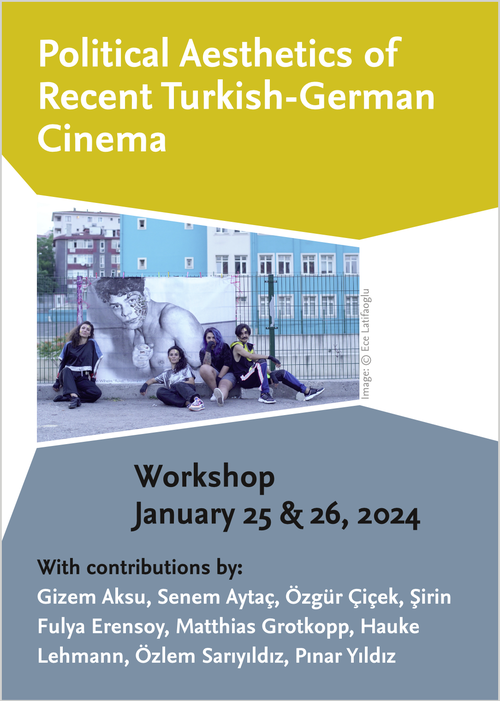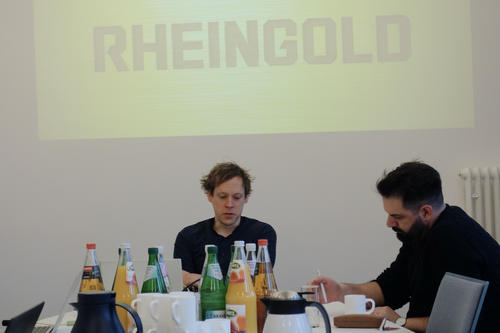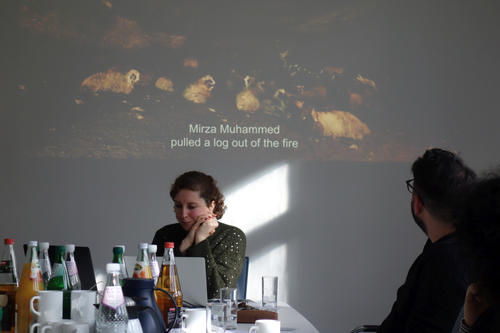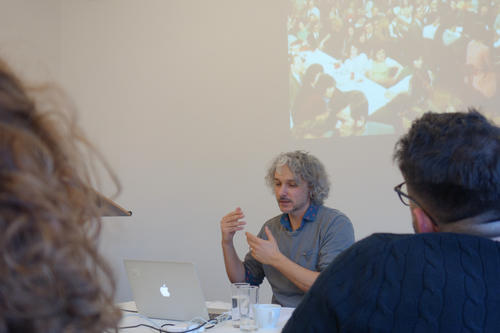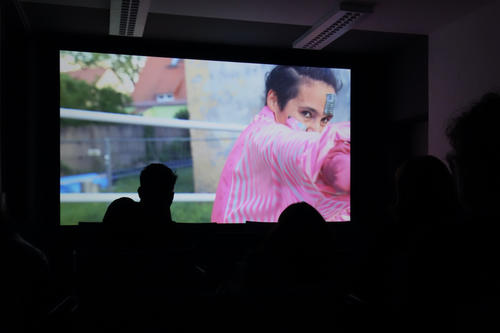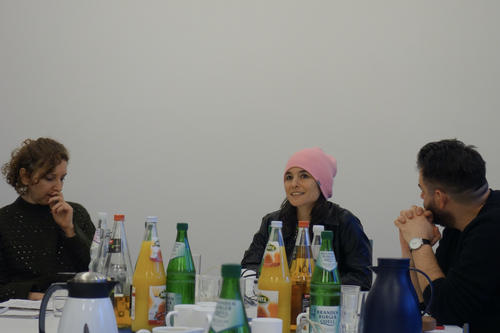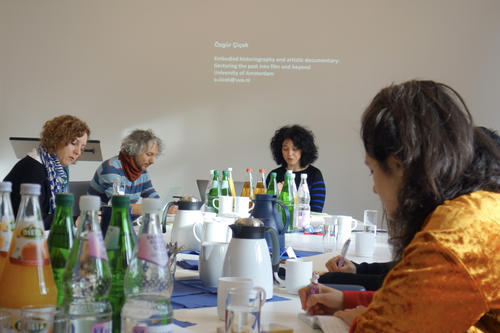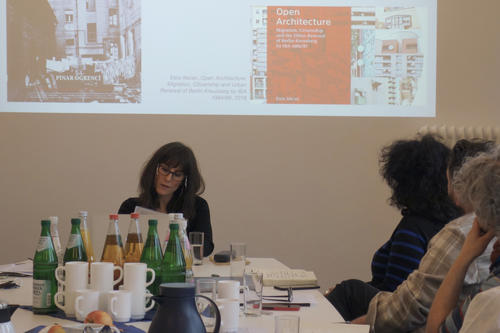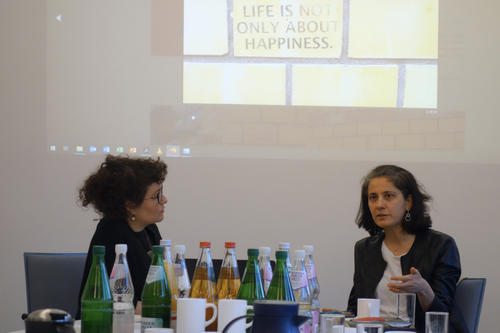Political Aesthetics of Recent Turkish-German Cinema
25. & 26.01.2024 | Workshop by the Cinepoetics group with Gizem Aksu, Senem Aytaç, Özgür Çiçek, Şirin Fulya Erensoy, Matthias Grotkopp, Hauke Lehmann, Özlem Sarıyıldız and Pınar Yıldız
Research Focus: Historical Phenomenology
Asking the question of how Turkish-German cinema has evolved in recent years, this workshop looked closely at the last decade of audio-visual productions in this field, focusing especially on newly emerging narratives as well as on questions of aesthetics, memory, and gender.
In her introductory remarks, Pınar Yıldız referred to possible factors contributing to a change in recent cinematic narratives of Turkish-German experience – like the migration wave of academics following the 2016 abortive coup.
The first day started with Hauke Lehmann’s presentation on "The Political Uses of the Gangster Film in Recent Turkish-German Cinema". In his presentation Lehmann pointed to dreams as a central motif in Turkish-German films, depicting the pursuit of happiness as a desire of migration in the tradition of the American imaginary. He talked about the gangster film genre as an astonishingly complete presentation of the American dream and pointed to the gangster figure in recent Turkish-German productions. Using the example of RHEINGOLD (Fatih Akın, 2022), Lehmann showed how the film breaks with genre conventions by using the melodramatic gesture of navigating through time and space as its main theme and aesthetic pattern: The film creates a movement out of the restriction of the gangster bound to the city/street and away from the constrains of Turkish-German-ness. Lehmann illustrated these movements as an alternation between memories and fantasies and recognized that sharing new cultural fantasies allow for "new beginnings".
In the second presentation, "Resonated Memories: Ethical, Political, and Aesthetic Dimensions of Transnational Remembering in Cinema," Pınar Yıldız looked at emerging productions that find experimental narrative and aesthetic forms – like non-linear storytelling, conscious omissions, etc. – to represent the complexity of traumatic pasts.
In blurring time and space, these movies become sites of national and transnational remembering where histories within and beyond borders can resonate, she said. Furthermore, they portray migrants as an active part of reconstructing memory, which may lead us to an understanding of migrants as active carriers of remembrance.
Matthias Grotkopp proceeded with an analysis of Cem Kaya’s newest film, LOVE, DEUTSCHMARKS AND DEATH (2022) and spoke about "Music as Things – Cultural Modes of Making, Distributing and Collecting". Grotkopp contemplated the gesture of the film, describing it as "collecting things and people" and differentiated the collection from the archive as an individual practice that others can appraise of. The question of approval and value becomes transparent as this seems to allow meaning and purpose to depend on others finding something worth understanding. "It is the theatrical arrangement for this film that discovers their presentability," as Grotkopp put it. In its display of things and people as well as its re-collection of past trauma, the film attempts to create an almost complete picture, as if to show that everything that has not yet been acknowledged will eventually find its place.
Following the screening of 9/8 FIGHT 41 (2022, 29 min.) by Gizem Aksu, the day ended with the filmmaker and choreographer talking about her experiences in producing and presenting the documentary short film. For Aksu, the aspects of learning from and communicating with one another through movement and dance is not only a central motif of 9/8 FIGHT 41, but also an invitation to the audience that is intended to last beyond the cinematic reception.
The second day started with Özgür Çiçek’s presentation, "Embodied Historiography and Artistic Documentary: Gesturing the Past into Film and Beyond," which provided a theoretical framework for Gizem Aksu's theses from the previous day.
Understanding archives as never complete or fully exhaustible, Çiçek pointed to Turkish-German post-cinematic productions that strive for a different way of recognizing and discovering the past. As her key examples she mentioned ÖTEKILER (Ayşe Polat, 2016) and 9/8 FIGHT 41 (Gizem Aksu, 2022). Instead of approaching blank spaces through mere thought, these films motivate us to walk, dance and move through cinematic narratives of history, she argued. A gesture that continues even after the reception, as a continuation of a predesign screen-space and something she described – with a nod to Miriam de Rosa’s work – as "dwelling with moving images," or what we might understand as: "Making something explicit by acting it out."
In the following presentation, "Migration and Identity: Feminist Perspectives in Contemporary Turkish-German Documentaries," Şirin Fulya Erensoy presented two films (LOOK, LISTEN CAREFULLY by Özlem Sariyildiz, 2021, and GURBET IS A HOME NOW by Pinar Ögrenci, 2021) that oppose dominant narratives of migration by placing female perspectives and experiences at the center of their narrative as well as their aesthetic choices. Understanding the urgency of letting first-generation immigrants tell their stories, these films let women talk, portraying domestic spaces as places of social (inter-)actions and thus work against the victimizing narrative of the entrapped migrant women.
The presentation was followed by a conversation between Senem Aytaç and the filmmaker Özlem Sarıyıldız. Looking through Sarıyıldız’s multifaceted body of work and her artistic journey from experimental short films to longer documentary formats, they touched on topics like modes of distribution, activism and collaboratory practices.
In the concluding remarks of the workshop, reference was made to Hannah Arendt and how the connection between ‘truth and trust’ can be reconciled with the connection between archive and collection. It was further noted how the workshop materials and presentations emphasized the unstable nature of reality and repeatedly returned to the question of what it means to be excluded from it.
